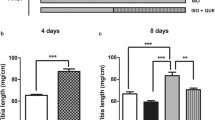Abstract
Changes in myocardial function, structure, high energy phosphates and lipid peroxide content were examined in hypertrophied hearts exposed to partially reduced forms of oxygen (PRFO) in an ex vivo system. Heart hypertrophy in rats was produced by narrowing of the abdominal aorta for 6, 12, 24, and 48 weeks. During this period, a stable hypertrophy and hyperfunction with no clinical signs of heart failure is reported to be accompanied by an increase in myocardial superoxide dismutase and glutathione peroxidase activities and a decrease in lipid peroxide content (Gupta and Singal, Circ. Res. 64:398–406, 1989). A 10-min perfusion of sham control hearts with PRFO caused a significant decline in the developed force, ± dF/dt and a rise in resting tension. These changes due to PRFO were significantly less in all groups of hypertrophied hearts. PRFO produced 80.8 ± 4.2 % increase in malondialdehyde (MDA) content in sham controls, while different groups of hypertrophied hearts showed significantly lesser increase (range 45–50 %) in MDA. PRFO resulted in loss of myocardial ATP and CP in control and hypertrophied groups, but this loss was significantly less in all groups of hypertrophied hearts. Both quantitative and qualitative ultrastructural changes due to PRFO were also found to be less in hypertrophied hearts. There were no significant differences among 6- to 48-week hypertrophy groups in their response to PRFO. The study suggests that endogenous antioxidants may serve as putative stabilizers of myocardial subcellular as well as contractile functions against oxidative stress.
Similar content being viewed by others
References
Blaustein AS, Schine L, Brooks WW, Fanburg BL, Bing OHL (1986) Influence of exogenously generated oxidant species on myocardial function. Am J Physiol 250:H595-H599
Burton KP, McCord JM, Ghai G (1984) Myocardial alterations due to free radical generation. Am J Physiol 246:H776-H783
Chambers DE, Parks DA, Patterson G, Roy R, McCord JM, Yoshida S, Parmley LF, Downey JM (1985) Xanthine oxidase as a source of free radical damage in myocardial ischemia. J Mol Cell Cardiol 17:145–152
Gerli GC, Beretta L, Bianchi M, Pellegatta A, Agostini S (1980) Erythrocyte superoxide dismutase, catalase and glutathione peroxidase activities in Beta-thalassemia (major and minor). Scand J Haematol 25:87–92
Guarnieri C, Flamigni F, Caldarera CM (1980) Role of oxygen in cellular damage induced by reoxygenation of hypoxic heart. J Mol Cell Cardiol 12:797–808
Gupta M, Gamerio A, Singal PK (1987) Reduced vulnerability of the hypertrophied rat heart to oxygen-radical injury. Can J Physiol Pharmacol 65:1157–1164
Gupta M, Singal PK (1987) Oxygen radical injury in the presence of desferal, a specific iron-chelating agent. Biochem Pharmacol 36:3774–3777
Gupta M, Singal PK (1989) Higher antioxidative capacity during a chronic stable heart hypertrophy. Circ Res 64:398–406
Gupta M, Singal PK (1989) Time course of structure, function and metabolic changes due to an exogenous source of oxygen metabolites in rat heart. Can J Physiol Pharmacol 67:1549–1559
Hess ML, Manson NH, Okabe E (1981) Involvement of free radicals in pathophysiology of ischemic heart disease. Can J Physiol Pharmacol 60:1382–1389
Higuchi M, Cartier LJ, Chen M, Holloszy JO (1985) Superoxide dismutase and catalase in skeletal muscle: Adaptive response to exercise. Gerontology 40:281–286
Hunter FE, Gebicke JM, Hoffstein PE, Weinstein J, Scott A (1963) Swelling and lysis of rat liver mitochondria induced by ferrous ions. J Biol Chem 238:828–835
Ishikawa T (1988) Cardiac defense mechanisms against oxidative damage. The role of superoxide dismutase and glutathione related enzymes. In: Singal PK (ed) Oxygen Radicals in the Pathophysiology of Heart Disease. Kluwer Academic Publishers, Boston, pp 91–109
Jackson CV, Mickelson JK, Pope TK, Rao PS, Lucchesi BR (1986) O2 free radical-mediated myocardial and vascular dysfunction. Am J Physiol 251:H1225-H1231
Jolly SR, Kane WJ, Bailie MD, Abrams GD, Lucchesi BR (1984) Canine myocardial reperfusion injury. Its reduction by the combined administration of superoxide dismutase and catalase. Ore Res 54:277–285
Kanter MM, Hamlin RL, Unverferth DV, Davis HW, Merola AJ (1985) Effect of exercise training on antioxidant enzymes and cardiotoxicity of doxorubicin. J Appl Physiol 59:1298–1303
Myers ML, Bolli R, Lekich RF, Hartley CJ, Roberts R (1985) Enhancement of recovery of myocardial function by oxygen free radical scavengers after reversible regional ischemia. Circulation 72:915–921
Nohl H, Hegner D (1979) Responses of mitochondrial superoxide dismutase, catalase and glutathione peroxidase activities to aging. Mech Ageing Dev 11:145–151
Plaa GL, Witsche H (1976) Chemicals, drugs and lipid peroxidation. Ann Rev Pharmacol 16:125–141
Sellevold OFM, Jynge P, Aarstad K (1986) High performance liquid chromatography: a rapid isocratic method for determination of creatine compounds and adenine nucleotides on myocardial tissue. J Mol Cell Cardiol 18:517–527
Singal PK, Dhillion KS, Beamish RE, Dhalla NS (1981) Protective action of zinc against catecholamine induced myocardial changes. Electrocardiographic and ultrastructural studies. Lab Invest 44:426–433
Singal PK, Kapur N, Dhillion KS, Beamish RE, Dhalla NS (1982) Role of free radicals in catecholamine-induced cardiomyopathy. Can J Physiol Pharmacol 60:1390–1397
Singal PK, Beamish RE, Dhalla NS (1983) Potential oxidative pathways of catecholamines in the formation of lipid peroxide and genesis of heart disease. Adv Exp Med Biol 161:391–401
Singal PK, Pierce GN (1986) Adriamycin stimulates low-affinity Ca2+ binding and lipid peroxidation but depresses myocardial function. Am J Physiol 250:H419-H425
Singal PK, Deally CMR, Weinberg LE (1987) Subcellular effects of adriamycin in the heart. A concise review. J Mol Cell Cardiol 19:817–828
Singal PK, Gupta M (1989) Role of free radicals in drug-induced myocardial effects. In: Miquel J, Quintanilha A, Weber H (eds) Handbook of Free Radicals and Antioxidants in Biomedicine. CRC Press Inc, Boca Raton, Florida, USA, vol 1:287–295
Woodward B, Zakaria MVM (1985) Effect of some free radical scavengers on reperfusion induced arrhythmias in the isolated rat heart. J Mol Cell Cardiol 17:485–493
Yterhus K, Myklebust R, Mjos OD (1986) Influence of oxygen radicals generated by xanthine oxidase in the isolated perfused rat heart. Cardiovasc Res 20:597–603
Author information
Authors and Affiliations
Rights and permissions
About this article
Cite this article
Singal, P.K., Gupta, M. & Randhawa, A.K. Reduced myocardial injury due to exogenous oxidants in pressure induced heart hypertrophy. Basic Res Cardiol 86, 273–282 (1991). https://doi.org/10.1007/BF02190607
Received:
Revised:
Issue Date:
DOI: https://doi.org/10.1007/BF02190607




